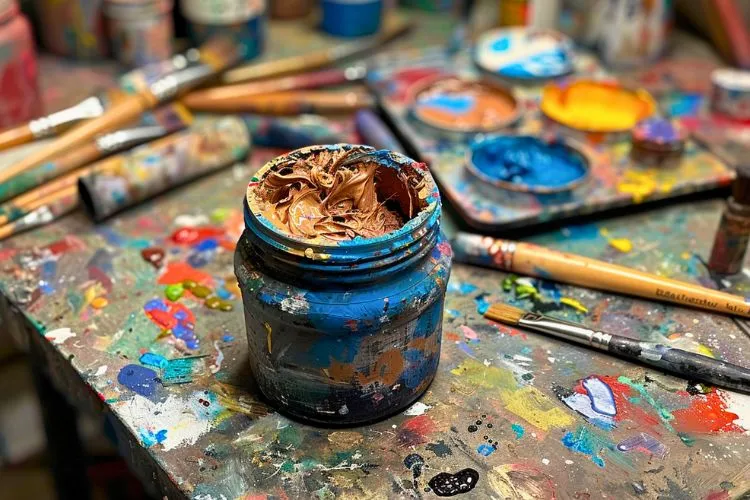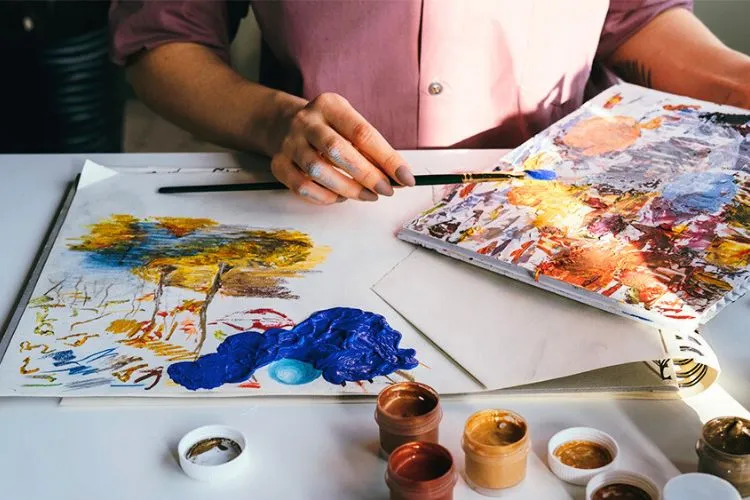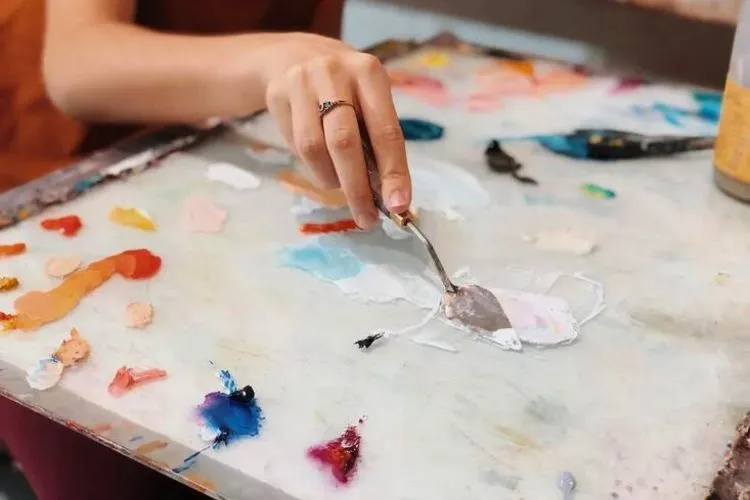When embarking on a painting project, whether it be refreshing furniture or crafting a piece of art, the choice between chalk paint and acrylic paint can significantly influence the outcome. Each has unique characteristics suited to specific applications.
This article delves into chalk paint Vs acrylic paint, the properties, uses, and considerations of both paints, guiding you towards making the best choice for your projects.

What is Chalk Paint?
Chalk paint, known for its matte finish, owes its unique texture to calcium carbonate. This paint adheres well to most surfaces without the need for sanding or priming, making it a favorite for upcycling furniture.

Its thick consistency offers excellent coverage, often requiring fewer coats than other paints. However, chalk paint’s porous nature means projects typically need a wax or sealant finish, adding to the overall time and cost.
What is Acrylic Paint?
Acrylic paint stands out for its versatility and durability. Composed of pigment suspended in an acrylic polymer emulsion, it dries to a water-resistant finish.

Suitable for a wide range of surfaces, acrylic paint can achieve various finishes, from glossy to satin, depending on the product chosen. Its quick drying time appeals to those who wish to complete projects rapidly.
Chalk Paint Vs Acrylic Paint
Composition and Ingredients
The main difference lies in their binders; chalk paint uses calcium carbonate, while acrylic paint uses acrylic polymer.
This distinguishes their texture and finish significantly. Chalk paint offers a velvety, matte look, whereas acrylic can range from matte to high gloss.
Opacity and Coverage
Chalk paint typically covers with fewer coats, owing to its thick consistency and high pigment load. Acrylic paint might require more layers to achieve full opacity but offers a broader range of finishes.
Finish and Aesthetic
The finish is where these two paints diverge sharply. Chalk paint’s matte finish provides a vintage feel perfect for shabby chic projects.
In contrast, acrylic paint offers more flexibility in sheen, from matte to gloss, accommodating a broader range of aesthetic preferences.
Drying Time and Re-coat Time
Acphalt paint dries faster than its counterpart, allowing for quicker layering. Chalk paint also dries relatively quickly but often necessitates a wax or sealant that extends the project’s total completion time.
You may also find useful: Fabric Paint Vs Acrylic Paint | Acrylic vs Latex Paint
Comparison of Suitability for Various Surfaces
Both paints adhere well to numerous surfaces. Chalk paint eliminates the prep work of sanding and priming on most surfaces. In contrast, acrylic paint may require priming to ensure longevity, especially on glossy or non-porous surfaces.
Preparing Surfaces for Chalk Paint and Acrylic Paint
Preparation can significantly impact the finish and durability. For chalk paint, minimal prep is needed, though a clean surface is crucial.

Acrylic painting might necessitate sanding and priming, particularly for slick surfaces where adhesion is a concern.
Techniques and Tools for Application
Application tools can vary based on the desired finish. Brushes, rollers, and even spray methods can be used effectively with both types of paint.
Chalk paint works well with natural bristle brushes for a textured effect, while acrylics pair well with synthetic brushes for a smoother finish.
Color Selection and Mixing
Chalk paint often comes in muted, vintage-inspired tones, aligning with its matte finish. Acrylic paints boast a broader spectrum of colors.
Both types allow for mixing to create custom shades, though the mixing ratios can affect the final consistency and drying time.
Durability and Longevity
Acrylic paint typically offers a more durable finish, resistant to the elements and wear. Chalk painted surfaces, unless properly sealed, can be more vulnerable to marks and stains. However, when correctly sealed, chalk paint can also withstand regular use.
Maintenance and Care
Maintaining painted surfaces ensures longevity. Acrylic paint cleans easily with soap and water. In contrast, chalk-painted surfaces might need special care, especially those finished with wax, which could require periodic reapplication.
Environmental Impact and Safety
Both paints have evolved to be more eco-friendly, with low VOC (Volatile Organic Compounds) options available.

Proper ventilation is still recommended during application, and appropriate disposal methods should be followed for environmental safety.
Cost Considerations
While chalk paint can be more expensive per unit, its superior coverage might offset the initial cost. Acrylic paint, potentially requiring more coats, could lead to similar overall project costs. Budgeting for additional supplies, such as sealants for chalk paint, is also essential.
Transforming Furniture: Chalk Paint Vs. Acrylic Paint
The choice between chalk paint and acrylic paint often comes down to the desired finish and the project’s nature. Chalk paint excels in achieving a vintage, matte look with minimal preparation, ideal for upcycling projects.
Acrylic paint’s versatility and durability make it suitable for a wider range of applications, offering varied finishes and quicker completion times.
Environmental and Health Considerations
Choosing the right paint impacts not only your project’s finish but also your health and the environment.
Both chalk and acrylic paints typically contain Volatile Organic Compounds (VOCs), which can release harmful chemicals into the air during application and drying. These emissions can contribute to air pollution and respiratory issues.

Therefore, opting for low or zero-VOC paints is crucial. Additionally, proper ventilation is essential when painting indoors to minimize inhalation exposure to these compounds.
By selecting eco-conscious products and employing safe practices, painters can reduce their environmental footprint and ensure a healthier workspace.
Frequently Asked Questions (FAQs)
Can chalk paint be used over acrylic paint?
Yes, but ensure the acrylic paint is clean and dry for the best adhesion.
Is acrylic paint waterproof once dried?
While acrylic paint is water-resistant, it’s not entirely waterproof and might require a sealant for outdoor use.
Can you mix chalk paint with acrylic paint?
It’s not recommended as they have different bases, which could affect drying time and finish.
Which paint is best for outdoor projects?
Acrylic paint, especially when sealed, tends to hold up better against the elements.
How do you seal and protect chalk paint surfaces?
Applying a wax or polyacrylic sealer can protect chalk-painted surfaces, enhancing durability.
Conclusion:
Both chalk paint and acrylic paint offer unique benefits suited to various projects. Understanding their differences, from composition to finish and application, can guide you to the best choice for your specific needs.
Experimenting with both paints will unlock a world of creative possibilities, allowing you to transform ordinary items into something extraordinary.

Meet Isabella Anderson, your acrylic painting mentor with over a decade of brush-wielding mastery. Dive into the colorful world of acrylics with her expert guidance, featured exclusively on ‘Acrylic Authority.’ Unleash your inner artist and explore the limitless possibilities of this versatile medium alongside a true acrylic aficionado.
